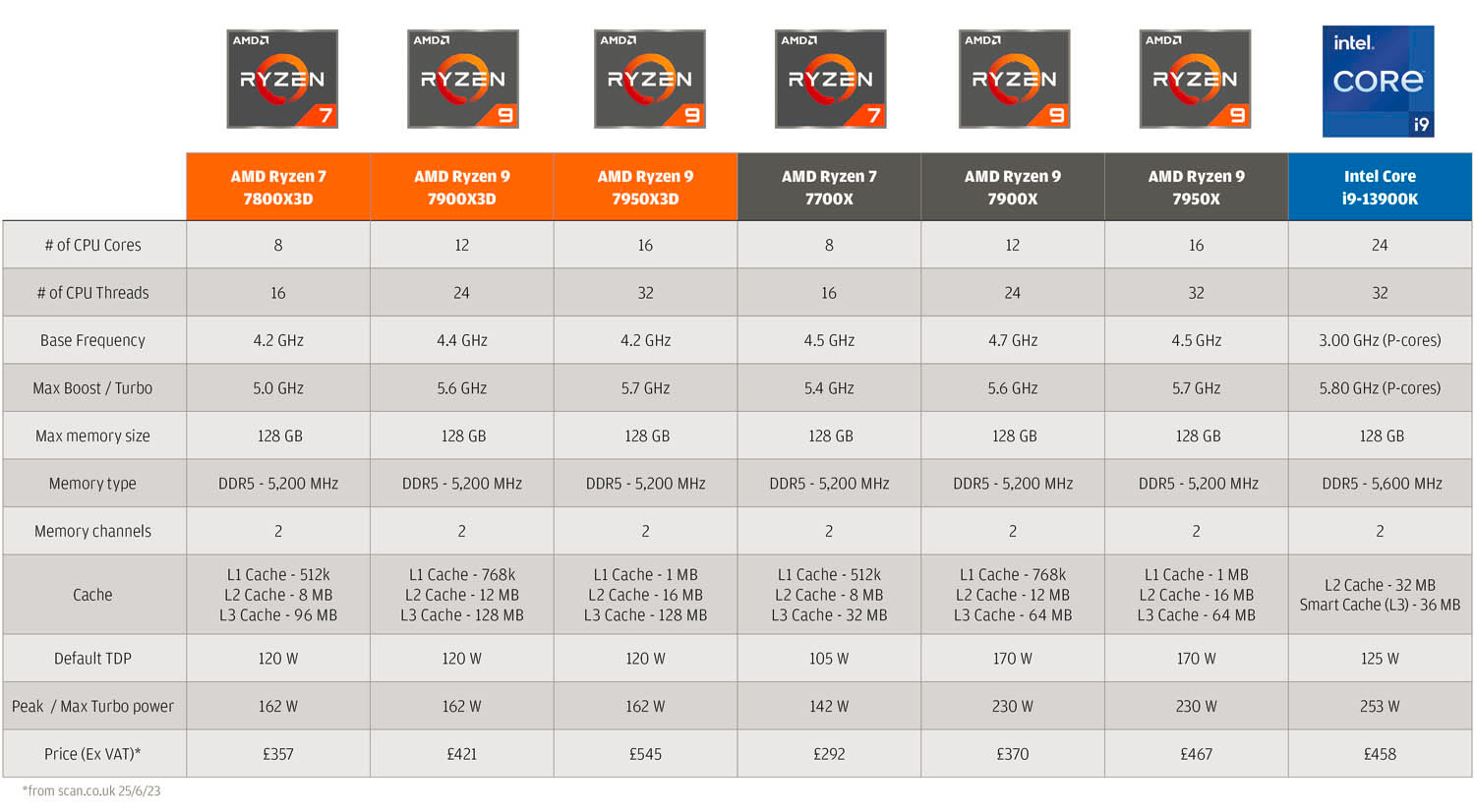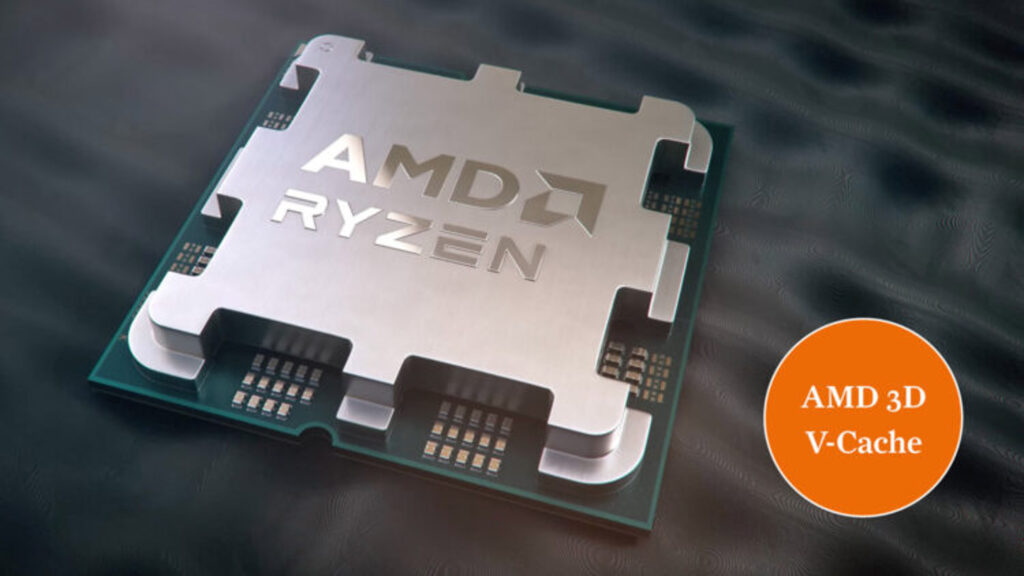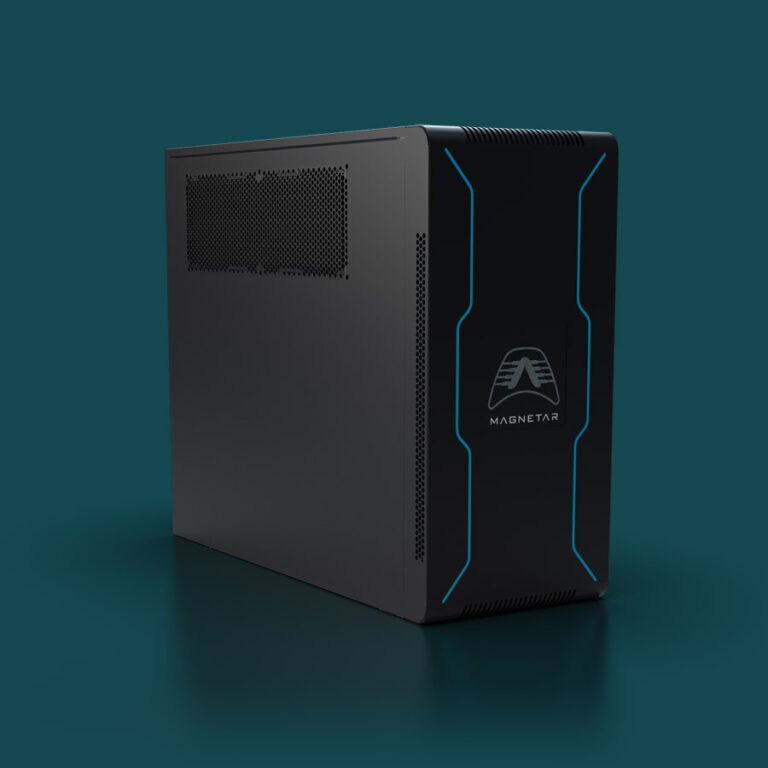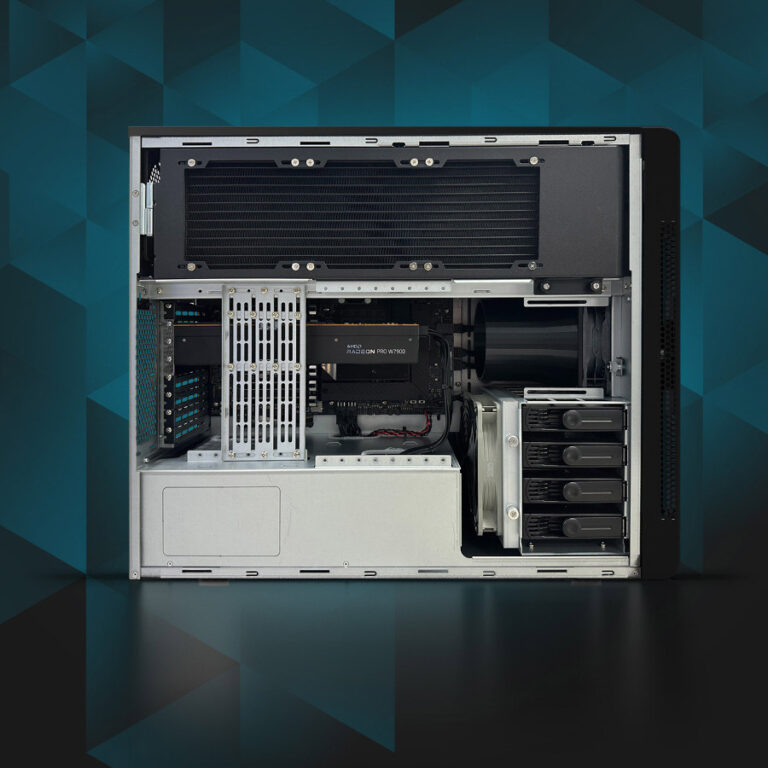AMD’s new Ryzen processors with 3D V-Cache deliver a real performance boost in 3D games, but what do they offer design and engineering professionals? Greg Corke explores
MD’s 3D V-Cache technology, built into select AMD Ryzen 7000 Series desktop processors, has been a huge success in the gaming sector over the past couple of years.
3D V-Cache allows for more L3 cache to be placed on the CPU by stacking it vertically instead of horizontally. The more cache a CPU has, the greater the chance of fetching the data it needs from cache instead of from slower system memory (RAM).
In some CPU-limited games, 3D V-Cache can lead to significantly better 3D performance. AMD has so much confidence in the technology it has even branded its 3D V-Cache Ryzen models ‘gaming processors’.
But are there any benefits for architects, engineers, or product designers, beyond those looking to get the edge in those after work sessions of Red Dead Redemption 2?
Before we get into answering that question, let’s have a look AMD’s 3D V-Cache Ryzen offerings.
AMD Ryzen 7000 X3D Series
AMD offers two different types of processors in its AMD Ryzen 7000 Series — those with 3D V-Cache (denoted by the X3D suffix) and those without (denoted by an X suffix or no suffix). The X3D models are slightly more expensive, but not by much.
There are three chips with 3D V-Cache — the 16-core Ryzen 9 7950X3D, 12-core Ryzen 9 7900X3D and 8-core Ryzen 7 7800X3D. All have 64 MB more L3 cache than their standard desktop counterparts but run at lower frequencies because they are harder to cool.
The 3D V-Cache processors differ largely by their number of cores, but this only tells part of the story. The Ryzen 9 7950X3D and Ryzen 9 7900X3D are made up of two different core compute die (CCD) ‘chiplets’ — one with 3D V-Cache and one without. For the Ryzen 9 7950X3D and Ryzen 9 7900X3D both chiplets have 8-cores and 6-cores respectively.
The 3D V-Cache chiplets run at a lower clock speed than the non-3D V-Cache chiplets. This architectural framework is important to understand, as it can impact performance if software doesn’t run on the best cores for the job (more on this later).
The Ryzen 7 7800X3D is different in that it only has a single 8-core 3D V-Cache CCD chiplet, so all cores run at a lower clock speed.

3D V-Cache on test
To explore which pro design workflows might benefit from 3D V-Cache, specialist UK manufacturer Armari lent us one of its high-performance Magnetar workstations, equipped with a single AMD Ryzen 9 7950X3D processor, 64 GB of DDR5 memory and an AMD Radeon Pro W7900 high-end workstation GPU. The full spec and mini review can be seen at the bottom of this article.
For testing we disabled each CCD in turn, using the AMD Ryzen Master Software. This method isn’t perfect. For a real-world comparison we should arguably use the same machine, first fitted with an AMD Ryzen 9 7950X3D processor, and then with its non-3D V-Cache counterpart, the AMD Ryzen 9 7950X. However, with our approach, isolating each CCD in turn brings real clarity to the potential benefits of AMD’s 3D V-Cache technology.
In order for 3D V-Cache to deliver a performance boost, any benefit of having fast access to a larger pool of frequently used data must outweigh the drop in frequency. And this drop can be quite big.
In Cinebench, for example, clock speeds in the single-threaded test were around 0.3 GHz to 0.4 GHz lower (reaching 5.35 GHz to 5.43 GHz on the standard CCD and 5.05 GHz on the 3D V-Cache CCD). There was a similar difference in the multi-threaded test (5.15 GHz on the standard CCD and 4.83 GHz on the 3D V-Cache CCD).
It was no surprise that the 3D V-Cache CCD was significantly slower in the SPECapc for Solidworks 2022 benchmark. Like most CAD software, Solidworks is largely single threaded, very dependent on processor frequency, and is not that sensitive to the speed at which data can be fed into the CPU. The same can be said for the majority of tests within the Invmark for Inventor benchmark, although the 3D V-Cache CCD did show a small lead in Dynamic Simulation.
The 3D V-Cache CCD showed no benefit in the ray trace rendering benchmarks, V-Ray and Cinebench, nor in the point cloud processing software, Leica Cyclone Register 360.
But there were some workflows where the 3D V-Cache CCD showed a significant advantage. When recompiling shaders in Unreal Engine it finished 14% faster. It also enjoyed a 16% lead in the Computational Fluid Dynamics (CFD) benchmark, WPCcfd (SPECworkstation 3.1), which simulates combustion and turbulence.
These results weren’t totally unexpected, as in our recent Intel Xeon ‘Sapphire Rapids’ vs AMD Ryzen Threadripper Pro article, both tests were shown to be sensitive to memory bandwidth.
There was no benefit in Rodinia, a CFD benchmark that represents compressible flow. However, as our ‘Sapphire Rapids’ memory bandwidth tests showed, it is not as memory intensive as other CFD benchmarks. The same is probably true of the Calculix Finite Element Analysis (FEA) benchmark.
We also tested the impact of 3D V-Cache on 3D graphics performance. In Solidworks 2022, the 3D V-Cache CCD delivered notably lower benchmark scores. This was not particularly surprising, however, as 3D graphics performance in most CAD applications is heavily influenced by CPU frequency, and the 3D V-Cache CCD runs about 0.3 GHz slower.
In Enscape and Unreal Engine, graphics intensive applications that are largely bottlenecked by the GPU, the gap was much smaller, with the standard CCD edging out the 3D V-Cache CCD at 4K resolution. Dialling down to FHD, which lightens the load on the GPU and therefore can elevate the role of the CPU, gave the 3D V-Cache CCD in Enscape a slight lead. But we’re talking about very fine margins here. Of course, other applications / datasets may yield different results.
Tuning the CPU
By default, all professional applications will prioritise the non-3D V-Cache cores. This is good for single threaded or lightly threaded CAD software, as our tests show that frequency is far more important for performance in these types of applications than having more cache.
Also, as the only workflows we found to benefit from 3D V-Cache are highly multi-threaded and make use of all of the CPU cores, assigning the right workflows to the right cores is not such a concern.
If you do find workflows that benefit from 3D V-Cache and run on fewer cores (and, of course if you are a gamer), then there are ways to manage which applications use the 3D V-Cache cores and which do not.
The easiest way to control this is through the Windows Game Bar using the ‘remember this is a game’ setting. Alternatively, use Process Lasso, a process automation / optimisation tool that allows processes to be permanently or temporarily assigned to specific cores.
Some applications are easier to configure than others, however. For example, when apps spawn separate executables for different compute intensive processes, each executable will need to be identified and then configured independently. In Solidworks, CAD, visualisation and simulation is a case in point.
Power efficiency
Compared to standard AMD Ryzen 7000 Series processors and (in particular) 13th Gen Intel Core processors, AMD’s 3D V-Cache Ryzen processors are incredibly power efficient.
The top-end AMD Ryzen 9 7950X3D has a Thermal Design Power (TDP) of 120W and a peak power of 162W. This is significantly lower than the non-3D V-Cache AMD Ryzen 9 7950X (TDP of 170W and peak power of 230W) and Intel Core i9-13900K (125W TDP and a max turbo power of 253W).
But specs only tell part of the story. In real world multi-threaded tests, our Armari workstation with AMD Ryzen 9 7950X3D draws noticeably less power than the other mainstream processors. This was observed at the plug socket, when measuring power draw of the overall systems — considering CPU, motherboard, memory, storage, and fans.
For example, in Cinebench R23, rendering with 16 cores and 32 threads, the AMD Ryzen 9 7950X3D workstation draws 251W. This is a full 90W less than an AMD Ryzen 9 7950X-based Scan workstation (341W) and almost half that of an Intel Core i9-13900K Scan workstation (451W). To put this in perspective, comparing Ryzen 9 7950X3D to Ryzen 9 7950X, you use 26% less power for only 6% less performance.
Power consumption in the single threaded Cinebench test is much more equal. The AMD Ryzen 9 7950X-based Scan workstation, Intel Core i9-13900K Scan workstation, and AMD Ryzen 9 7950X3D Armari workstation drew 127W, 122W, and 129W respectively.
Conclusion
If you simply look at benchmark scores for mainstream CAD and viz workflows, it’s easy to dismiss the AMD Ryzen 7000 X3D Series out of hand.
And while most architects, designers and engineers will not see a performance gain from 3D V-Cache, there are some specific professional workflows where it shows real promise.
The most likely beneficiaries are those that use simulation tools, including CFD and FEA, in workflows where the processor is often left waiting for data. On paper, the AMD Ryzen 7950X3D looks most capable — the other models have fewer cores and the Ryzen 7 7800X3D misses out on single threaded performance by not having a higher GHz standard CCD.
Of course, there are far better processors for hardcore multi-threaded simulation. The AMD Threadripper Pro 5000 Series and Intel Xeon W-2400 and W-3400 Series offer more cores, more memory bandwidth, and more memory capacity. But these processors can be very expensive.
For those on a budget, the Ryzen 7950X3D could offer a cost-effective way to reduce solve times in simulation software compared to standard desktop processors. The word ‘could’ is important here, as all CFD and FEA solvers behave differently. Even distinct datasets within the same application can have specific ways of using workstation resources, so in house testing is essential.
Finally, power efficiency deserves one last mention. The AMD Ryzen 7950X3D uses significantly less power than most modern desktop processors. And 6% less rendering performance for 26% less power will seem like a good trade-off for some.
Armari Magnetar M16R7-AD1000G3
Armari has a long history of developing specialist workstations, so it’s no surprise to see the UK firm offering the AMD Ryzen 9 7950X3D processor as an alternative to the AMD Ryzen 9 7950X.
Both processors are available in its Magnetar M16R7-AD1000G3 workstation (as reviewed here), which was recently replaced by the Magnetar M16R7-AW1350G4. In the new machine you get the same core specifications, but a few chassis tweaks, a new PSU, and better cooling to handle dual monster gaming GPUs.
Our review machine has a serious all-in-one liquid cooling system for the CPU with a colossal side mounted 360mm radiator. One wonders if this is overengineered for the power efficient AMD Ryzen 9 7950X3D, but you can’t argue with the impressive acoustics under heavy loads.
As we’ve found, the AMD Ryzen 9 7950X3D does well in data-intensive workloads so you want to ensure the CPU can be fed as fast as possible from memory and storage as it is from cache. With 64 GB of dual channel 6,000MHz memory pushing 52 GB/sec in the SiSoft Sandra memory bandwidth benchmark and a 4 TB NVMe RAID 0 array delivering 13,970 MB/sec read and 12,709 MB/sec write in the CrystalDiskMark benchmark it doesn’t disappoint for a system of this type. WiFi 6E is built into the Asus ProArt X670E-Creator WiFi motherboard, and you also get 10 Gb Ethernet for the fastest data transfer rates.
For graphics, there’s a single Radeon Pro W7900, AMD’s brand-new high-end workstation GPU with a whopping 48 GB of memory.
As we found in our in-depth review, it doesn’t hit the heights of the NvidiaRTX 6000 Ada Generation, but then it’s half the price. It’s a great GPU for those working with colossal datasets in specific viz workflows, although arguably the AMD Ryzen 9 7950X would be a better fit here.
If you play to the strengths of the Ryzen 9 7950X3D, and intend to use the machine for engineering simulation then downgrade the GPU, ramp up the RAM to 128 GB and set your CFD solver to work.
Specifications
- AMD Ryzen 9 7950X3D processor (16 cores, 4.2 GHz base, 5.7 GHz max boost)
- 64 GB (2 x 32 GB) Corsair Vengence DDR5-6000 C40 memory
- AMD Radeon Pro W7900 (48 GB) pro GPU
- Asus ProArt X670E-Creator WiFi motherboard
- 4 TB AMD NVMe RAID 0 array with 2 x 2 TB Solidigm P44 Pro SSDs
- Microsoft Windows 11 Pro
- 3 Year RTB workstation warranty
- £6,195 (Ex VAT)
- + £150 for upgrade to M16R7-AW1350G4 workstation base








